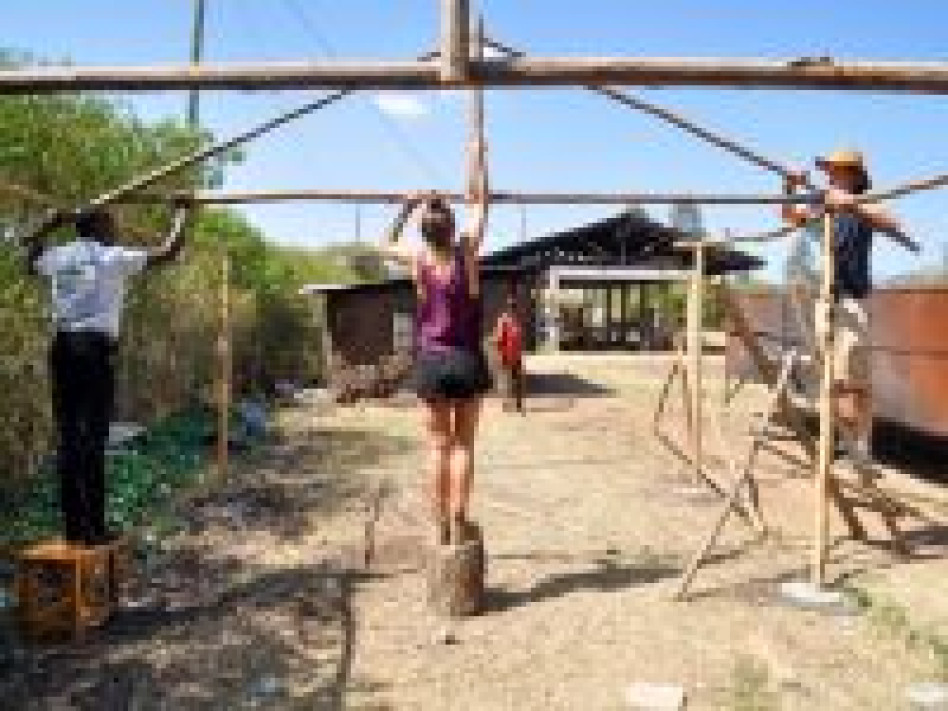After our meeting with the board of Sustainable Rural Initiatives (SRI), to whom we showed our prototype of the BamGoo, we used the upcoming weeks to close off the BamGoo project. We have build a new prototype taking the various comments made by the board into account. One of these was shortening the front of the frame to ensure easier movement through the narrow marketstreet in Africa. To maintain the loading capacity, the backrack was enlarged. All the materials used for the second prototype where still leftover from the previous build. Therefore this second BamGoo was quickly build.
It’s about time to take our BamGoo-bike to a local market and see what the local community actually thinks. With both the BamGoo and the bike in one single tuktuk we moved ourselves to the tuesdaymarket in Ahero, a village about 20 minutes out of Okana. The local community was very interested in both us and our BamGoo. We interviewed a couple of salesman and took some pictures with their produce on the BamGoo. By talking to them we found out that most of these salesman have to travel a long way to the various markets, which means using a bike as transportation is not a viable option. Next to that their estimated price was around 1000 shiling (10 euro), eventhough the productioncost of the latest prototype is already 1500 shiling. Besides this again the problem of the bike not being strong enough arose, when we loaded the BamGoo. The frame itself is very sturdy, but our trusted bike was clearly struggling under the weight.
Using all the information gathered we used the lasts weeks of December to make an analysis of implementating the BamGoo in an area like the Okana-region. The conclusion was that there are some circumstances that are in the way of successfully implementing the BamGoo in this particular area. The most important factors are; the strength of the bike, which in most cases is not sufficient enough in comparison with the weight the BamGoo can carry. The distance from and to the markets, which is often too long to use a bike for. And the production costs of the BamGoo, which currently is too high to actually create a demand for the BamGoo in a under developed area like the Okana-region.
Since the BamGoo is not going to generate income for SRI any time soon, we have decided to develop some new ideas that will attribute to the financial self-sustainability of the Pavilions. We stayed flexible and thought about new ideas to generate income. We came up with several designs for a chicken run as well as for a cafeteria to accompany the resource center. We think that both these concepts will be able to generate income on the long run. Luckily the chairman of the SRI, James Jowi, was on the compound most of December. This enabled us to meet with him concerning these ideas several times, as well as with Laura and Ellen, the two architects behind the Pavilions. They reacted enthusiastic towards our designs and the research about the technical aspects. While meeting with Jowi it became clear that the cafeteria would be mostly used for the volunteers and not the local community. Therefore the chicken run seemed to have more potential to generate income. In the week before Christmas we decided to shift the remaining funds from the BamGoo project to investing in building a chicken run..
After an amazing Christmas Holidays in Kenya we started building a chicken run in januari. In this particular construction we used bamboo as a material, so the design suits the Pavilions, and to create more bamboo awareness in Okana. We have used left over bamboo from the resource center construction. Besides this we invested in chickenwire, wood and cement. These will be used to create a house for the chickens to sleep and breed accompanied by an outside run. With the help of the local employees it was easy to get all this material together. In our last three weeks in Okana we quickly build this establishment. Only the finishing touch still needs to be done before the run is ready for its new inhabitants. The construction is large enough to hold about 50 chickens. As a starting point we will leave SRI with a total of 10 chickens.
With a special thanks to S4S we were able to build the prototypes for the BamGoo. We appreciate the flexibility S4S has shown us towards the shift of funding we decided to make, which allowed us to build a chicken run as a income generating facility for SRI. Next week we will look for the prettiest chicken and will release them in our chicken run. This will be a very satisfying end to our adventure in Kenya

